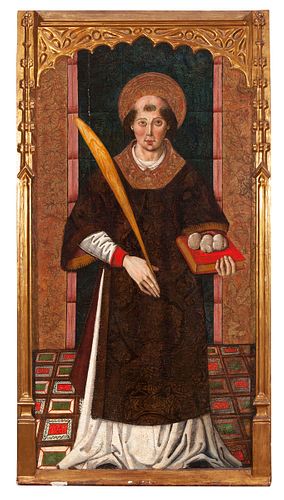Catalan school of the second half of the fifteenth century. "St. Stephen", ca. 1480. Tempera painting on panel and gold background.
Lot 17
About Seller
Setdart Auction House
Carrer Aragó 346
Barcelona
Spain
Setdart Subastas was born in 2004 and is currently the first online art auction in Spain with solidity, prestige and reliability guaranteed by our more than 60,000 users. Setdart has a young, dynamic and enterprising team ready to successfully manage the purchase and sale of art works through custom...Read more
Estimate:
EUR€12,000 - EUR€15,000
$12,500 - $15,625
Absentee vs Live bid
Two ways to bid:
- Leave a max absentee bid and the platform will bid on your behalf up to your maximum bid during the live auction.
- Bid live during the auction and your bids will be submitted real-time to the auctioneer.
Bid Increments
| Price | Bid Increment |
|---|---|
| EUR€0 | EUR€10 |
| EUR€200 | EUR€25 |
| EUR€500 | EUR€50 |
| EUR€1,000 | EUR€100 |
| EUR€3,000 | EUR€200 |
| EUR€5,000 | EUR€500 |
| EUR€10,000 | EUR€1,000 |
| EUR€20,000 | EUR€2,000 |
| EUR€50,000 | EUR€5,000 |
About Auction
By Setdart Auction House
Oct 20, 2021
Set Reminder
2021-10-20 07:30:00
2021-10-20 07:30:00
America/New_York
Bidsquare
Bidsquare : OLD MASTERS
https://www.bidsquare.com/auctions/setdart-auction-house/old-masters-7700
Setdart Auction House sofia@setdart.com
Setdart Auction House sofia@setdart.com
- Lot Description
Catalan school of the second half of the fifteenth century. "St. Stephen", ca. 1480. Tempera painting on panel and gold background. Measures: 154 x 79 cm; 161 x 85.5 cm (total). Gothic panel of the fifteenth century with a frame topped with a poly-lobed arch. It is the representation of St. Stephen, staged standing and haloed, in frontal position. The saint carries in his left hand the stones of stoning, these in turn resting on the gospel. Also, in the other hand, the palm that identifies him as a martyr. Formally this work already shows us an important advance with respect to the international Gothic style that dominated the panorama in all Europe during the 14th century. Thus, although the line continues to maintain its prominence, a more naturalistic representation of the volumes begins to be sought, and attention is paid to detail and quality that responds to a direct Flemish influence. However, the panel maintains the full body, a resource that monumentalizes the figure and makes it more corporeal, losing the stylization of the previous century. We also see the attention to detail of Flemish origin in areas such as the hair, painted almost hair by hair, the palm or the tiles that make up the floor. The deacon Stephen, whose name means crown, was the first martyr of the Christian faith, who was stoned by the Jews, who accused him of blaspheming Moses. According to a 10th century manuscript dedicated to his biography, on the day he was born he was snatched away by Satan, who replaced him in his cradle with a small demon. He then left the child girdled at the door of a bishop named Julion, who discovered the child being suckled by a white doe and adopted him. Some time later Stephen returned to his father's house, and with the sign of the cross expelled the demon that occupied his place. Ordained deacon by the apostles, he argued with the Jewish rhetoricians, who had him arrested and condemned for blasphemy to death by stoning. Regarding his patronages, he belongs to the category of holy healers, and was considered to have the power to heal ringworm. Because of the stones from his stoning, he was invoked against stones and headaches. In Germanic countries, the legend attributed him to have been the stableman of King Herod, so he was considered the patron saint of horses, coachmen and drivers. He was also the patron of slingers, because of his stoning. St. Stephen has as main attributes, from the 15th century, a book or a sheet and the stones of his stoning, as we see here.
- Shipping Info
-
In-house shipping available. Please inquire at admin@setdart.com.
-
- Buyer's Premium



 EUR
EUR CAD
CAD AUD
AUD GBP
GBP MXN
MXN HKD
HKD CNY
CNY MYR
MYR SEK
SEK SGD
SGD CHF
CHF THB
THB







